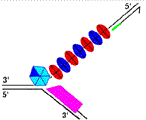Department of Chemistry

Mark A. Griep Publications
Document Type
Article
Date of this Version
7-1-2006
Abstract
Bacterial primases are essential for DNA replication due to their role in polymerizing the formation of short RNA primers repeatedly on the lagging-strand template and at least once on the leading-strand template. The ability of recombinant Staphylococcus aureus DnaG primase to utilize different single-stranded DNA templates was tested using oligonucleotides of the sequence 5’-CAGA (CA) 5 XYZ (CA) 3-3’, where XYZ represented the variable trinucleotide. These experiments demonstrated that S. aureus primase synthesized RNA primers predominately on templates containing 5’-d(CTA)-3’ or TTA and to a much lesser degree on GTA-containing templates, in contrast to results seen with the Escherichia coli DnaG primase recognition sequence 5’-d(CTG)- 3’. Primer synthesis was initiated complementarily to the middle nucleotide of the recognition sequence, while the third nucleotide, an adenosine, was required to support primer synthesis but was not copied into the RNA primer. The replicative helicases from both S. aureus and E. coli were tested for their ability to stimulate either S. aureus or E. coli primase. Results showed that each bacterial helicase could only stimulate the cognate bacterial primase. In addition, S. aureus helicase stimulated the production of full-length primers, whereas E. coli helicase increased the synthesis of only short RNA polymers. These studies identified important differences between E. coli and S. aureus related to DNA replication and suggest that each bacterial primase and helicase may have adapted unique properties optimized for replication.


Comments
JOURNAL OF BACTERIOLOGY, July 2006, p. 4673–4680 Vol. 188, No. 13 Copyright © 2006, American Society for Microbiology. All Rights Reserved. Permission to use.